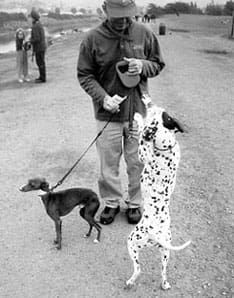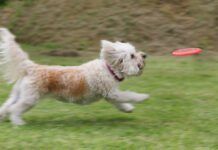My nine-month-old Bouvier puppy is in training, but I am having trouble finding a positive way to stop his lunging; he is very strong. I am using a choke chain, and my current trainer feels I’m not firm enough in my corrections. I don’t feel comfortable using the choker, but also don’t like the idea of the Halti because it might be even more dangerous if he lunged.
-Carol via e-mail
———-
Pat Miller, WDJ’s Dog Training Editor, answers this question for us. Miller offers private and group dog training classes from her base in Fairplay, Maryland. For contact information, click here.
Miller responds:
Kudos to you for resisting your trainer’s advice to jerk harder on your pup’s choke chain. Choke chains have been shown to cause spinal subluxations in dogs that were trained with them. In worst-case scenarios, trainers using choke chains have damaged and collapsed dogs’ tracheas, and in some cases even killed dogs.
Head halters are, if used correctly, a much safer way to manage lunging while you train your pup to act properly on leash. I prefer the Snoot Loop and the Gentle Leader to the Halti, as the Halti seems more susceptible to slipping off the dog’s nose (see “Head Halters Right and Wrong,” WDJ June 2000). I recommend using two leashes – one clipped to the head halter, the other to the dog’s regular collar. If he lunges, you can absorb the shock with the regular collar, then use gentle pressure on the head halter to turn him away from the object of his attention.
Then, of course, you must reward the appropriate behavior with a reward marker (such as the Click! of a clicker or the word “Yes!”), followed by a yummy treat. If you use the halter without the marker and treat, you are managing his behavior, but not training him to offer you the correct behavior voluntarily. If you only manage the behavior without training, you may always need the halter to control him. If you train him to perform the desired behavior by rewarding him when he’s not lunging, you should eventually be able to wean him off the halter.
If you are really concerned about using the head halter you can try the J.S. Sporn Halter (actually a harness, which tightens around the dog’s legs and chest when he pulls). Again, you will need to actually train the behavior you want, not just rely on the equipment to change your dog’s behavior.
Socialization is important
It’s also important to understand why he’s lunging, and to work on training him out of that behavior as well. Is it aggression, or is he lunging out of a friendly desire to visit approaching people or dogs? Either way, avoid verbal or physical punishment (corrections). If he begins to associate pain or stress with the approach of others, he may well become aggressive.
Instead, teach him a rewarding, incompatible behavior – such as looking at you with rapt attention – using Clicks! and tasty treats, so he associates the approach of others with really wonderful stuff coming from you. If he is lunging at other dogs because he wants to go play with them, teach him that the way to get to go play with other dogs is to be calm and sit looking up at you. Do this by always having him sit and pay attention before you release him to go play.
More and more trainers are coming to realize the value of positive training methods. You might want to ask your trainer if she will allow you to use positive methods in your class, or find one who can help you train more positively.






